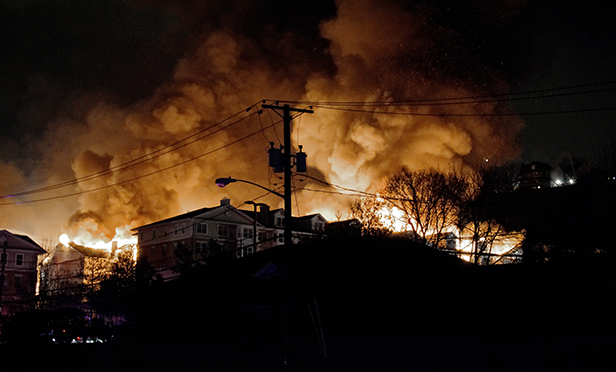 The 2015 fire that destroyed a large portion of Avalon at Edgewater is a major impetus for the movement to tighten building construction safety codes. (Steven Brener photo from Flickr.com under Creative Commons license)
The 2015 fire that destroyed a large portion of Avalon at Edgewater is a major impetus for the movement to tighten building construction safety codes. (Steven Brener photo from Flickr.com under Creative Commons license)
ATLANTIC CITY, NJ—A coalition of companies from the concrete industry is joining with state legislators and fire officials to encourage the state legislature to strengthen New Jersey's building codes with higher safety standards for new mid- and high-rise lightweight construction.
More than three years after a fire decimated the Avalon at Edgewater multifamily complex, state officials, labor, fire safety experts, and eight counties representing 56% of the state's population say that New Jersey must strengthen its buildings using non-combustible materials to ensure safety to its communities.
“We want to make fire safety a priority in New Jersey to prevent against the vulnerabilities of combustible materials that can allow fires to spread rapidly,” said NJ Senate President Steve Sweeney (D-Gloucester/Salem/Cumberland), who has thrown his support behind Assembly Bill 135 and Senate Bill 1261. “Firefighters and residents are put in harm's way by massive fires resulting from lightwood construction.”
New Jersey has been the site of major fires at wood-framed apartment complexes and structures, most notably in Lakewood, Maplewood, and Edgewater—the latter displacing more than 500 residents.
“We know the industry, we've worked in the industry and we want to make sure that our construction practices are built up to 2018 standards moving forward,” said deputy assembly speaker Wayne P. DeAngelo, the Assembly bill's primary sponsor.
“It was easy for me, after the fire in Edgewater, to advocate for the change in legislation to have sprinklers, masonry walls and separation and compartmentation as part of the uniform construction code and laws here in New Jersey,” says Jim Tedesco, Bergen County Executive. Bergen County was the most recent county to pass a resolution in support of the legislation, bringing support for the legislation to more than half of the New Jersey population.
Besides the eight counties supporting the safety code changes, fire and labor leadership are lining up as well. Ed Donnelly, president of the New Jersey Firefighters Mutual Benevolent Association says the legislation is critical in improving fire safety standards across the state of New Jersey.
“This is a common-sense piece of legislation that is going to protect the residents of New Jersey,” says Donnelly. “This legislation is long overdue and its time we get this done, without question.”
Build with Strength, an advocacy initiative established by the National Ready Mixed Concrete Association, has been lobbying against what it calls “the inherent dangers of wood-framed construction, particularly in multi-story, residential and commercial buildings.” But the group says it's not just promoting the self-interest of concrete producers.
“We have legislators, we have firefighters, we have county officials, there are affordable housing groups,” says Alexis Marvel, associate vice president, political operations and media strategy, with DDC Public Affairs, a Washington, DC-based political strategy firm that represents the Build with Strength program. “There is a very broad and diverse set of individuals and organizations that support the strengthening of building codes in New Jersey and across the United States, because frankly, it comes down to human life. Human life is at stake, devastating economic consequences.”
Construction that mainly relies on timber may not be appropriate as climate change creates greater fire hazards, Marvel says.
“If you look at what's happening in California, it's a perfect case study,” she says. “You don't need the climate of California and the Santa Ana winds to see that when you have buildings that are built from timber, in the cases of mid- and high-rise buildings, you're putting families, communities, neighbors, at risk.”
Meanwhile, Avalon Bay Communities has embraced the need to reduce fire risk in wood frame multifamily projects. The company says it focuses on four “key pillars” that use a combination of innovative building processes, new technologies, and a novel wood treatment to help reduce and/or eliminate structural fires. Although designed with wood frame structures in mind, Avalon Bay says this approach could have applications for fire loss prevention and elimination beyond the wood frame construction industry. Avalon Bay received the 2018 Gary E. Bird Horizon Award for its fire suppression methods at the 38th annual International Risk Management Institute Construction Risk Conference earlier this month.
“It's an honor to be recognized with this prestigious award when our efforts are a result of wanting to do the right thing for our industry, associates, trade partners and residents,” says Michael Feigin, AvalonBay's chief construction officer. “We are now sharing our efforts with industry groups and our REIT and multifamily peers in the hope that we can make the entire industry safer for everyone.”
© 2025 ALM Global, LLC, All Rights Reserved. Request academic re-use from www.copyright.com. All other uses, submit a request to [email protected]. For more information visit Asset & Logo Licensing.








